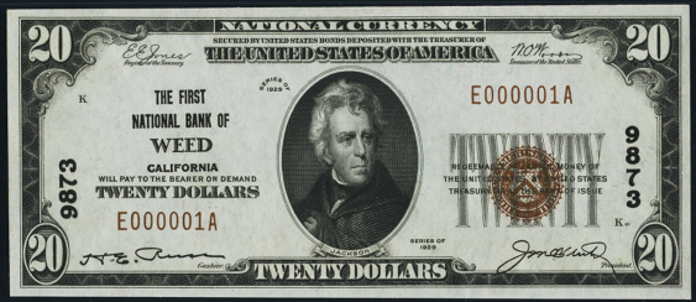Twenty Dollar Notes › Nationals › 1929 Twenty Dollar National Bank Notes › Indiana Charters › 1929 $20 Cayuga Indiana First National Bank
Get Value Now
| Item | Info |
|---|---|
| Series | 1929 |
| Charter | #9189 First National Bank of Cayuga, Indiana |
| Year Chartered | 1908, 323 Banks Chartered |
| City Info | Cayuga is a town in Eugene Township, Vermillion County, in the U.S. state of Indiana. The population was 1,162 at the 2010 census. When the town was laid out on September 20, 1827, it was called Eugene Station, though it was also called Osonimon after an Indian chief of that name. It was later renamed after the village of Cayuga and Cayuga Lake in the state of New York; an early settler named John Groenendyke had originally come from Cayuga County, New York and moved to Vigo County in 1818, then in 1819 moved to the area that later became Vermillion County. The name is based on the Iroquois term Gwa-u-geh, meaning "the place of taking out". Local legend attributes the name to the sound made by the horn of a Ford Model T. The town was incorporated around 1891. Source: Wikipedia |
| Similar Cities | City name is unique, no others like it. |
| Seal Varieties | Small Brown |
| See Also | If your note doesn't match try: 1. 1929 $20 Federal Reserve Bank Note 2. 1928 $20 Federal Reserve Note 3. 1928A $20 Federal Reserve Note 4. 1928B $20 Federal Reserve Note 5. 1928C $20 Federal Reserve Note 6. 1934 $20 Federal Reserve Note |
| Other Info | 1. Value depends on notes known for charter, condition and market demand. |
| Neat Fact | Full and partial sheets of National Bank Notes are known to exists. Families of bank officials, particularly those who signed the notes, kept them as keepsakes. Some sheets are extremely valuable. Others are more common. |
No Obligations Offers and Appraisals
Please submit a good photo or scan. It will be identified and evaluated. Understand there may be subtle differences between the image you see above and your note. Signatures, design, markings and note condition will determine the offer price. Notes in Uncirculated or better condition receive the best offers.
Appraisals can be estimated for wholesale and retail prices. Wholesale is what dealers typically pay. Retail is what a collector might pay. Retail is slightly higher in most cases.
Please visit this page for USA Paper Money Reference. Do not treat this page as a reference guide, it is for appraisal and acquisition purposes only.
